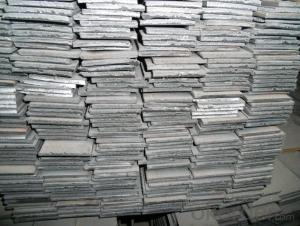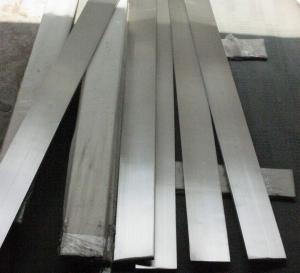Steel flat bars; Flat steel
- Loading Port:
- Tianjin
- Payment Terms:
- TT OR LC
- Min Order Qty:
- 2000 m.t.
- Supply Capability:
- 10000 m.t./month
OKorder Service Pledge
OKorder Financial Service
You Might Also Like
Product Description:
Production Flow of STEEL FLAT SS400
The steel flat bar is made through three processes:
1.Feeding the material: Feeding the row material (the steel plate) to Slitting Line.
2.Slitting:The steel plate would be slitted into expected width by lengthways cutter.
3. Leveled and cutting: The plat bar would be ground into level by the grinder and then cut into required length
Tangshan flat bar processing plant
Our factory was founded in 2008, has been formed steel processing, trade, distribution, haihe river transportation and information service in the integration of modern company, the headquarters is located in the national steel rich district of tangshan city, hebei province, the first big province, covers an area of 20 mu, is apart from the beijing-shenyang high-speed 0.5 kilometers tangshan north exit, the geographical position is superior, the traffic is convenient.
The company owns the most advanced domestic shear steel equipment, plasma cutting equipment, can according to customer demand for steel plate kaiping, slitting, crosscutting, shear and winding and other personalized processing services, enable customers to save steel cut expenses and losses, greatly reduce the production cost, improve production efficiency. Its main products are steel billet, steel strip, flange plate and web plate, flat steel, open the tablet, etc.
Products applied to the export of flat steel, steel structure, steel plate, cars, ships, cement, steel girder plate socket, machinery manufacturing, bridge template, and other industries. Processing width: 10 mm - 1250 mm, the thickness of 1.5 mm - 16 mm, the length can be due to the needs of customers, annual processing capacity of 100000 tons. Product quality in line with the GB/T 709-2006carbon structure and hot rolled steel plate and strip of low alloy structure" of the relevant requirements.
In the increasingly market competition, the company in good faith integrity, mutual benefit and win-win principle sincerely look forward to cooperating with you!
Product description:
Processing capacity: 100000 tons/year; Slitting precision (width) : 0.5 mm or less
Raw material: Q235B, Q345B, Q235-1 b crosscutting precision (length) : 2 mm or less
Processing: the thickness of 2.0-16 mm; Shear length: 2000 mm above
Wide degree: 15-1250 - mm; Leveling precision: 1-2 MMM squared
- Q:Can steel flat bars be used for fencing or security purposes?
- Yes, steel flat bars can be used for fencing or security purposes. They are durable, sturdy, and can provide a strong barrier for protection.
- Q:What are the different techniques for joining steel flat bars together?
- There exists a variety of methods for connecting steel flat bars, which depend on specific needs and uses. Some commonly employed techniques include welding, bolting, riveting, and adhesive bonding. 1. Welding is extensively utilized for joining steel flat bars. It involves heating and melting the edges of the flat bars in order to fuse them together. The selection of welding method, such as arc welding, gas welding, or laser welding, depends on the thickness and composition of the steel bars. 2. Bolting is an effective means of connecting steel flat bars, particularly when disassembly is required. This technique involves drilling holes in the flat bars and securing them together using bolts, nuts, and washers. Bolting provides a robust and dependable connection but may require periodic maintenance to prevent loosening. 3. Riveting entails driving a metal pin or rivet through pre-drilled holes in the steel flat bars. The rivet is then deformed on the opposite side, creating a permanent connection. Riveting is commonly employed in structural applications that demand high strength and rigidity. 4. Adhesive bonding involves applying a strong adhesive between the surfaces of the steel flat bars to create a bond. This technique is suitable for connecting thin flat bars or situations where welding or drilling is not feasible. Adhesive bonding results in a clean and aesthetically pleasing joint, but it may have limitations in terms of strength and durability. 5. Mechanical fasteners, such as clips, clamps, or brackets, can also be used to connect steel flat bars. These fasteners are designed to hold the flat bars in place without the need for welding or drilling. While mechanical fasteners offer ease of installation and disassembly, they may not provide the same level of strength as welding or riveting. It is crucial to carefully select the appropriate joining technique based on factors such as the intended use, load requirements, design limitations, and the properties of the steel flat bars.
- Q:Can steel flat bars be used in architectural designs?
- Yes, steel flat bars can be used in architectural designs. They are versatile and can be used for various structural and decorative purposes such as framing, support beams, handrails, and cladding. Their durability, strength, and sleek appearance make them a popular choice in modern architectural designs.
- Q:Are steel flat bars resistant to wear or abrasion?
- Yes, steel flat bars are highly resistant to wear and abrasion. The hardness and durability of steel make it an excellent choice for applications where resistance to friction and abrasion is crucial. Steel flat bars can withstand heavy loads and repeated impact, making them ideal for various industries such as construction, manufacturing, and machinery.
- Q:Are steel flat bars used in structural engineering?
- Steel flat bars are a common choice in structural engineering for a variety of applications. These versatile flat bars can be used to construct beams, columns, braces, and other structural elements. They provide essential support and stability in buildings, bridges, and infrastructure projects. Steel flat bars are renowned for their strength, durability, and resistance to deformation, making them an excellent option in structural engineering. They can be effortlessly welded, bolted, or riveted to other steel components, enabling efficient and cost-effective construction. In summary, steel flat bars are vital in structural engineering and have extensive use in the industry.
- Q:How do steel flat bars behave under high temperatures?
- Steel flat bars behave differently under high temperatures depending on the specific grade and composition of the steel. However, in general, steel flat bars tend to lose their strength and stiffness when exposed to high temperatures. They may start to deform, buckle, or even melt if the temperature exceeds the steel's melting point. It is crucial to consider these factors when using steel flat bars in high-temperature applications to ensure structural integrity and safety.
- Q:The minus sign in front of what 40 galvanized flat steel
- Also called hot galvanized and hot dip galvanizing: hot dip galvanizing is an effective way of metal corrosion, mainly used for metal structure on the facilities of the industry. The steel piece after being cleaned is dipped into the molten zinc liquid at about 500 DEG C so that the zinc coating is adhered on the surface of the steel member so as to prevent corrosion.
- Q:Are steel flat bars resistant to fire?
- Generally, steel flat bars are resistant to fire. Steel, being a non-combustible material, does not burn or aid in the spread of fire. Due to its high melting point and excellent heat resistance, steel is highly resistant to fire. As a result, steel flat bars are commonly used in construction, manufacturing, and industrial settings where fire resistance is necessary. However, it is important to remember that while steel itself is fire-resistant, other materials attached to or surrounding the steel bars may not be. Therefore, it is crucial to consider the entire system and ensure that all components are fire-resistant to provide maximum fire protection.
- Q:What are the different methods of joining steel flat bars?
- There exist multiple techniques for connecting steel flat bars, each having distinct advantages and constraints. 1. The most typical approach is welding. This involves fusing the edges of the bars together, which then cool and solidify to form a robust bond. Welding offers versatility, with options like arc welding, gas welding, or spot welding. 2. Bolting is another well-liked method. It entails drilling holes in the bars and securing them with bolts and nuts. Bolting allows for easy disassembly and reassembly, making it suitable for temporary connections or situations requiring frequent maintenance. 3. Riveting involves using metal fasteners called rivets to join the bars. A hole is drilled through the bars, and a rivet is inserted and secured by hammering or mechanical pressing. Riveting provides a strong and permanent connection, but it demands specialized tools and skills. 4. Adhesive bonding is a method employing industrial adhesives to connect steel flat bars. The adhesive is applied to the surfaces, and pressure is applied to achieve a robust bond. Adhesive bonding can be a viable alternative when welding is unsuitable or when a more visually appealing joint is desired. However, its bond strength may be lower compared to welding or mechanical fastening methods. 5. Mechanical fasteners, such as screws, nails, or clips, can also be used to join steel flat bars. These fasteners are inserted into pre-drilled holes or slots in the bars and tightened to secure the connection. While mechanical fasteners offer quick assembly and disassembly, their strength may not match that of welding or riveting. When choosing the appropriate method for joining steel flat bars, it is crucial to consider factors like the intended use, load-bearing requirements, aesthetics, and ease of assembly. Each method has its own advantages and constraints, and the best choice will depend on the specific application.
- Q:Can steel flat bars be heat treated?
- Yes, steel flat bars can be heat treated. Heat treatment is a process used to alter the mechanical and physical properties of steel, such as increasing its hardness or improving its strength. Heat treating steel flat bars involves heating the material to a specific temperature range and then cooling it rapidly or slowly, depending on the desired outcome. This process can enhance the flat bars' strength, toughness, and wear resistance.
1. Manufacturer Overview |
|
|---|---|
| Location | |
| Year Established | |
| Annual Output Value | |
| Main Markets | |
| Company Certifications | |
2. Manufacturer Certificates |
|
|---|---|
| a) Certification Name | |
| Range | |
| Reference | |
| Validity Period | |
3. Manufacturer Capability |
|
|---|---|
| a)Trade Capacity | |
| Nearest Port | |
| Export Percentage | |
| No.of Employees in Trade Department | |
| Language Spoken: | |
| b)Factory Information | |
| Factory Size: | |
| No. of Production Lines | |
| Contract Manufacturing | |
| Product Price Range | |
Send your message to us
Steel flat bars; Flat steel
- Loading Port:
- Tianjin
- Payment Terms:
- TT OR LC
- Min Order Qty:
- 2000 m.t.
- Supply Capability:
- 10000 m.t./month
OKorder Service Pledge
OKorder Financial Service
Similar products
New products
Hot products
Related keywords




























